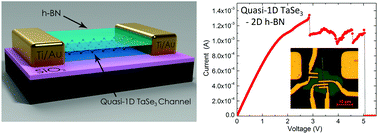Breakdown current density in h-BN-capped quasi-1D TaSe3 metallic nanowires: prospects of interconnect applications†
Abstract
We report on the current-carrying capacity of the nanowires made from the quasi-1D van der Waals metal tantalum triselenide capped with quasi-2D boron nitride. The chemical vapor transport method followed by chemical and mechanical exfoliation were used to fabricate the mm-long TaSe3 wires with the lateral dimensions in the 20 to 70 nm range. Electrical measurements establish that the TaSe3/h-BN nanowire heterostructures have a breakdown current density exceeding 10 MA cm−2—an order-of-magnitude higher than that for copper. Some devices exhibited an intriguing step-like breakdown, which can be explained by the atomic thread bundle structure of the nanowires. The quasi-1D single crystal nature of TaSe3 results in a low surface roughness and in the absence of the grain boundaries. These features can potentially enable the downscaling of the nanowires to lateral dimensions in a few-nm range. Our results suggest that quasi-1D van der Waals metals have potential for applications in the ultimately downscaled local interconnects.


 Please wait while we load your content...
Please wait while we load your content...